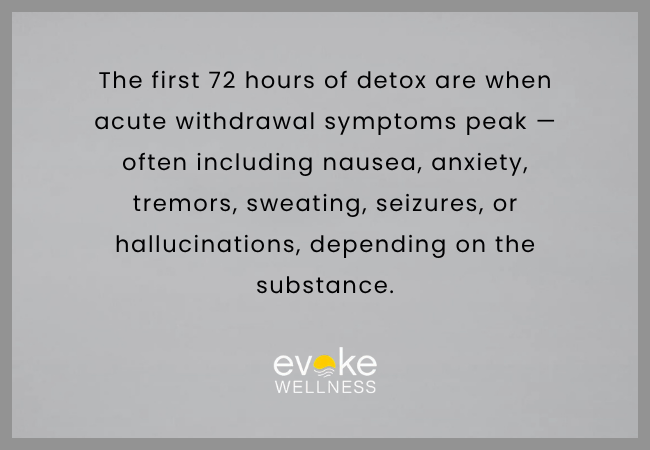When someone struggling with addiction makes the decision to enter detox, the first 72 hours are often the most physically and emotionally intense. These initial three days are critical—they set the foundation for successful long-term recovery and can shape a person’s overall treatment experience. Understanding what happens during this period helps individuals and their loved ones prepare for the journey ahead with clarity, realism, and hope.
Detox is the process of clearing the body of toxic substances—most often drugs or alcohol—while managing withdrawal symptoms safely. During this time, the body begins to readjust to functioning without the substances it had become dependent on. The symptoms that arise, as well as the severity and timing, depend on several factors including the type of substance used, the duration of use, the amount consumed, and the individual’s health status.
Entering detox under the guidance of trained professionals ensures both safety and comfort, which is why medically supervised detox is always recommended. The following breakdown offers an inside look at what someone might experience during each phase of the first 72 hours.
The First 6–12 Hours
Shortly after the last dose or drink, the withdrawal process begins. For substances like alcohol, benzodiazepines, and opioids, withdrawal symptoms can start as soon as six hours after use has stopped. Early symptoms are usually mild and may include anxiety, restlessness, irritability, sweating, and trouble sleeping.
At this stage, medical teams perform initial assessments—monitoring vital signs, conducting lab work, and determining the severity of dependence. These evaluations help clinicians determine the safest course of action for managing symptoms. Many clients are provided with hydration support and medication to ease discomfort and reduce the risk of complications.
Emotional vulnerability is also common during this early window. Clients may feel overwhelmed, uncertain, or even tempted to leave. Having access to compassionate, non-judgmental staff makes a world of difference during these difficult first hours.
12–24 Hours In
As the first full day progresses, withdrawal symptoms often intensify. Depending on the substance, individuals may experience nausea, muscle aches, tremors, fever, irritability, or insomnia. For opioid and stimulant users, cravings can become especially strong, while those detoxing from alcohol or benzodiazepines may begin to show signs of more serious symptoms such as hallucinations or seizures.
Medical staff remain close by to manage emerging symptoms, adjusting medications as needed and providing around-the-clock supervision. In some cases, additional support such as IV fluids or anti-nausea medications are introduced. Psychological support becomes more critical at this stage as anxiety or depression may spike.
Clients are encouraged to begin a light routine—short walks, hydration, and simple meals, if tolerated. These small acts of structure help re-establish physical and emotional stability and give the body a sense of rhythm that’s vital for long-term healing.
24–48 Hours Into Detox
By the second day, most people begin to experience the peak of their withdrawal symptoms. For those detoxing from alcohol, this period can be especially dangerous. Delirium tremens (DTs)—characterized by confusion, high blood pressure, seizures, and even hallucinations—can emerge in extreme cases. Opioid withdrawal typically peaks during this time as well, presenting with flu-like symptoms such as vomiting, diarrhea, muscle pain, sweating, and extreme restlessness.
Medications, such as buprenorphine or clonidine, may be used to alleviate distress and stabilize physical responses. At this stage, clients often feel physically exhausted, mentally drained, and emotionally raw.
While the physical symptoms dominate the experience, the emotional toll becomes more visible too. Many people report feelings of guilt, hopelessness, or fear about what lies ahead. Therapeutic support becomes essential here—simple check-ins with counselors or group facilitators offer clients the chance to express these emotions and begin developing insight into their condition.
48–72 Hours After Last Use
As the third day begins, many individuals notice a slight shift. While withdrawal symptoms may still be present, they often begin to lessen in intensity. Energy levels start to return in short bursts, and appetite typically improves. Clearer thinking slowly returns, and while emotions may still feel heavy, some people begin to feel a cautious optimism.
During this time, the medical team evaluates progress and determines whether further detox support is needed. In some cases—such as with long-acting substances like methadone or extended benzodiazepine use—symptoms can continue beyond 72 hours. But for many, this milestone marks a transition point.
Therapeutic engagement becomes more active. Clients might begin attending group therapy sessions or educational workshops that focus on understanding addiction, managing cravings, and building coping skills. These initial steps into the therapeutic environment create momentum for the next stage of recovery.
Routine also plays a vital role. Meals are shared in a calm and structured setting, light exercise or yoga may be introduced, and sleep becomes more regulated. These simple, consistent habits are powerful tools in early healing, helping reset both mind and body.
The goal of the first 72 hours is not just to manage withdrawal—it’s to stabilize the individual physically, emotionally, and mentally, setting them up for the next step in treatment. This time is as much about rebuilding strength as it is about safely removing substances from the body.
One of the most important aspects of a successful detox is being in a safe and supportive environment. A Medical Detox Center in Ohio provides this foundation, ensuring clients have access to both expert clinical care and compassionate emotional support from the very beginning of their recovery journey.
From there, clients may transition into longer-term care, whether that’s a Residential Treatment Program in Ohio or other level of care, depending on individual needs and progress. Detox is never a stand-alone solution—it’s the start of a full continuum of healing.
In Ohio, many individuals begin this journey at a specialized Drug Detox Center in Ohio where safety and comfort are prioritized. For those detoxing from alcohol specifically, medically managed support at an Alcohol Detox Center in Ohio ensures the risks associated with alcohol withdrawal are appropriately handled.
In addition to detoxing the body, this time allows clients to start reflecting on the underlying causes of their addiction. Some may require more comprehensive mental health support, which can be provided through a Mental Health Treatment Center in Ohio, ensuring that co-occurring conditions are recognized and treated simultaneously.
At this phase, individualized treatment planning begins, preparing the client to step into an Intensive Inpatient Treatment Program in Ohio or a longer-term care model that best fits their needs and progress. As clients begin to re-engage with life, decision-making and clarity return, and the path forward becomes clearer.
For anyone beginning their recovery at an Addiction Treatment Center Ohio, the first 72 hours may seem daunting—but they are also full of hope. It’s the start of something new, a clean slate, and an opportunity to break free from the grip of substance use.
Why Choose Evoke Wellness?
Choosing the right detox and treatment facility is critical to your long-term success. At Evoke Wellness at Hilliard, we are committed to your safety, comfort, and progress from the moment you arrive. Our medically monitored detox programs are designed to support individuals through the most challenging parts of withdrawal with dignity and respect.
What sets us apart is our comprehensive, individualized approach. Whether you’re beginning detox or transitioning to further care, our team is with you every step of the way. From medical professionals to experienced therapists and support staff, we offer the stability and compassion you need to begin recovery with confidence.
As a premier Addiction Treatment Center Ohio, we are focused on your long-term healing—not just symptom management. With 24/7 support, evidence-based practices, and a calming, restorative environment, you can trust that you’re in the right place to take your first step toward lasting change.
Conclusion
Detox is a physically demanding and emotionally intense process, particularly within the first 72 hours. But with the right support, it’s also the most important first step toward recovery. Whether you or a loved one is ready to start this journey, Evoke Wellness at Hilliard is here to guide you through every moment. Call us today at 866-430-9267 to speak confidentially with our caring team and learn more about how we can help you begin again.
Frequently Asked Questions (FAQs)
What is detox, and why is the first 72 hours important?
Detox is the medical process of clearing substances from the body. The first 72 hours are crucial because they often include the most intense withdrawal symptoms and set the tone for ongoing treatment.
How do symptoms vary by substance during detox?
Withdrawal symptoms vary depending on the substance. For example, opioids may cause flu-like symptoms, while alcohol withdrawal can lead to more severe effects such as seizures or delirium tremens.
Is detox painful or dangerous?
Without medical supervision, detox can be both painful and potentially life-threatening. Supervised detox minimizes risk, manages discomfort, and ensures safety through clinical support.
What happens after the detox process ends?
Once the acute withdrawal phase ends, clients often transition into residential or inpatient treatment, where they begin therapeutic work focused on long-term recovery.
Can I detox at home instead of a facility?
While home detox might seem convenient, it is rarely safe—especially with alcohol, benzodiazepines, or opioids. Medically supervised detox offers safety, comfort, and higher success rates.



